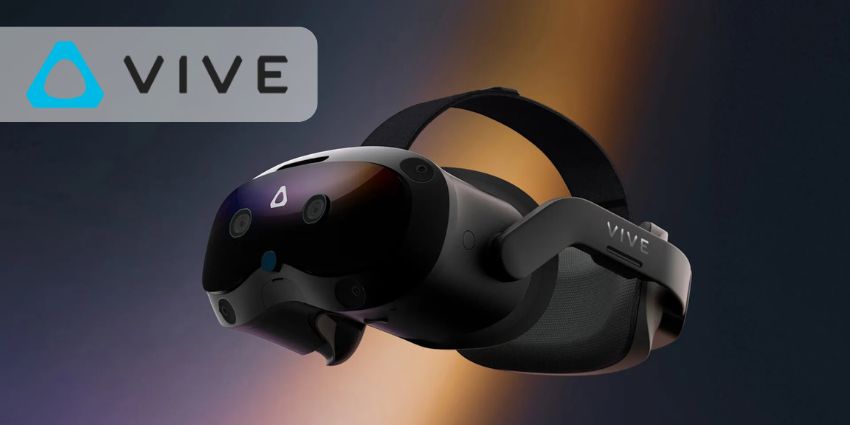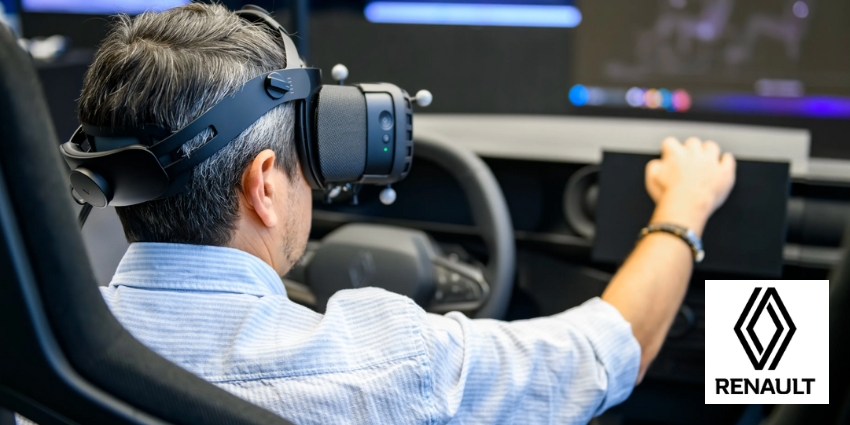The HTC VIVE Focus Vision is now available to pre-order, and we’re excited about its potential for the enterprise market.
However, the hype around this headset might be confusing for some. After all, many of the specs of this “premium” headset come straight from the much older VIVE Focus 3. Preserving old tech, including the previous-generation Snapdragon processor, might seem like an odd move for VIVE.
After all, we’re currently seeing rapid innovation in the XR market. Meta announced its affordable Meta Quest 3S headset at Connect, as well as showing off impressive pair of new augmented reality glasses. PICO introduced a new mid-range PICO 4 Ultra headset.
Plus, we’ve had new announcements from Snap, new rumors from Apple, and new innovations in VR locomotion, like the Virtuix Omni One to explore. So, what makes the HTC VIVE Focus Vision such a significant upgrade from its predecessor – particularly for enterprise users?
What is the HTC VIVE Focus Vision? An Overview
The HTC VIVE Focus Vision is the latest “premium” headset announced by VIVE this year. Although VIVE has an excellent reputation for producing relatively high-end headsets (particularly in the PCVR market), this is the first device focused on both consumers and enterprise users.
The company is releasing two versions of the headset, one for consumers (costing $999), and one for enterprise users (for $1,299). Unlike some VIVE devices. This headset can be used either as a standalone wearable, or connected to a PC via USB-C and DisplayPort.
According to HTC VIVE’s team, the new headset brings a wealth of improvements to the previous VIVE Focus 3 headset, with stronger mixed reality features, enhanced tracking capabilities, and an added depth sensor. However, most of the specs list still seems almost identical to the VIVE Focus 3.
You’ll still get the same 2,448 x 2,488 resolution per eye, a 120-degree field of view, and a 90HZ refresh rate. Plus, VIVE is still using Fresnel lenses (similar to those in the Quest 3S), instead of pancake lenses. Here’s a quick run-down of the specs.
HTC VIVE Focus Specs
- Screen: 2 x LC Panels
- Resolution: 2448 x 2448 pixels per eye
- Refresh rate: 90Hz
- FOV: Up to 120 degrees
- Microphones: Dual microphones with noise/echo cancellation
- Speakers: Dual driver directional speakers
- Processor: Qualcomm Snapdragon XR2
- Memory and storage: 12GB RAM and 12GB ROM (Up to 2TB expandable storage)
- Connections: USB Gen 1 Type C port and DisplayPort
- Sensors: Tracking cameras x 4, G-Sensor, two high-res passthrough cameras, 2 x tracking cameras, depth, proximity, G sensor, infrared floodlight, and gyroscope.
- Battery: Removable hot-swappable battery with average 2-hour life
HTC VIVE Focus 3 vs the HTC Focus Vision
So, if the specs are so similar – why is the VIVE Focus Vision such a major upgrade? The VIVE Focus 3 was already an excellent device when it was introduced in 2021. It was even adopted by a lot of enterprise users, alongside consumers.
However, today, thanks to innovations by Meta and the new Apple Vision Pro, this device does seem a little outdated. It only offers greyscale pass-through, for instance, and doesn’t include eye tracking, depth sensors, or advanced hand tracking.
The VIVE Focus Vision takes all of the beneficial features of the Focus 3, and builds on them with new capabilities that make this device a true competitor in the enterprise space. Although it’s still not as advanced as some high-end headsets (thanks in part to it’s older chipset), the Focus Vision does offer a significant upgrade, at a relatively low price.
Here are our insights into the key upgrades that make the VIVE Focus Vision a more attractive upgrade for enterprise users.
HTC VIVE Focus Vision: The Design and Ergonomics
The HTC VIVE Focus 3 did have a decent design, with good weight distribution and well-placed buttons and triggers. However, from a comfort perspective, the Focus Vision does a lot of things extremely well. First, it comes with an easy-to-clean PU leather trim, which is ideal for keeping your headset hygienic, particularly if you’re sharing it with multiple users.
Thanks to the built-in eye tracking features, it also comes with automatic eye comfort adjustment. That means you don’t have to worry about using a wheel or dial to get the perfect viewing experience.
Perhaps the most impressive upgrade is the integrated cooling system. While the Vision 3 did have fans to help keep the device cool, the Vision Focus can manage a 30% higher air intake, giving you a much more significant “cooling” experience.
The VIVE Focus might not look as “premium” in design as something like the Apple Vision Pro—it definitely features a lot more plastic elements. However, the overall design does make the device feel more lightweight and flexible. You can even leave your glasses on when using the device because they fit neatly within the headset.
Enhanced Mixed Reality Experiences
As mentioned above, the HTC VIVE Focus 3 only had greyscale passthrough options, making it less appealing to many mixed reality fans than even the cheaper Meta Quest 3. The new VIVE Focus Vision supports excellent full-color passthrough. Although there’s a little warping in places, you still get a much more immersive mixed-reality experience overall.
To enhance the “immersion” you’ll experience with this headset, VIVE has significantly upgraded its tracking capabilities. Now, eye-tracking is included as standard, which means developers can integrate eye-tracking features into their apps to create a wide range of new solutions.
Eye tracking will make it easier for users to access gaze-based controls to navigate content. The Apple Vision Pro has already shown just how beneficial such functionality can be. Plus, the hand-tracking capabilities have received a major upgrade too.
Although the previous device did support hand-tracking, the headset’s 4 cameras and infrared floodlight make it easy to interact with content with exceptional precision. Even in low-light conditions, the infrared illuminates your hands with 26-point precision.
The headset even comes with scene understanding, powered by a depth sensor, to help you virtually interact with the surfaces and objects in your environment.
Display and Audio Upgrades
Although the resolution, field of view, and refresh rates on the VIVE Focus Vision are the same as those you’ll get from the Focus 3, there are still some upgrades to the display and audio. First, you’ll get better full-color passthrough as mentioned above. You also get a better PC streaming experience.
The VIVE Focus Vision gives you a new “lossless streaming” experience with DisplayPort mode, which is extremely useful for companies using PCVR for design purposes. However, it’s worth noting that the DisplayPort streaming kit is sold separately for consumers, costing around $199 extra. Plus, you’ll need a relatively high-quality PC and graphics card to get the best experience. However, it’s a fantastic upgrade if you’re looking for a high-fidelity experience.
From an audio perspective, VIVE is using open-back, dual driver speakers to deliver a spatial audio experience, with minimal sound leakage. You also get a set of noise and echo-cancelling microphones, perfect for immersive collaboration sessions.
Software, Performance, and Battery Life
Again, the VIVE Vision Focus does use the same (slightly outdated) Qualcomm Snapdragon processor as the previous headset. That means you probably won’t notice any significant upgrades to performance, particularly in standalone mode. However, it also features extra RAM (12GB instead of 8GB) to keep your content running smoothly.
Plus, although you only get 128GB of onboard storage, you can add a MicroSD card to the headset for up to 2TB of additional storage. From a software perspective, you can access most of the same apps and tools you’d use with the Focus 3.
However, VIVE has introduced the “VIVE Desk,” specifically designed for companies that want to visualize, create, and multitask in mixed reality settings.
Probably the most significant upgrade is the introduction of a truly hot-swappable battery. While the VIVE Focus 3 would need to be switched off when you changed the batter, the Focus Vision has a small internal battery. This keeps your device running for up to 20 minutes when you’re swapping out your power sources. That’s excellent if you’re going to be using your headset for lengthy collaboration or design sessions.
The HTC VIVE Focus Vision: A Step Forward for Enterprise Users
At a glance, the HTC VIVE Focus Vision might not seem to introduce many upgrades to the Vision Focus 3. However, we think the company has definitely introduced some significant changes that will make this headset more appealing, specifically to enterprise users.
Although the company is targeting both the consumer and business landscape with this new headset, the new features definitely seem more tuned to business needs. Better passthrough, more stable processing, integrated eye-tracking, and enhanced hand-tracking are all ideal for enterprise teams.
This newly updated headset seems to be primarily focused on companies searching for reliable, functional, and affordable XR devices that will advance their research and development strategies. It even comes with open drivers and SDKs for customization.
In our opinion, this headset’s biggest downside is that it lacks the performance that would have been afforded by a next-generation chipset. Still, the plus side is that a cheaper processor has made it easier for HTC to deliver its new headset at a price point that makes it more accessible to a wide range of companies.







